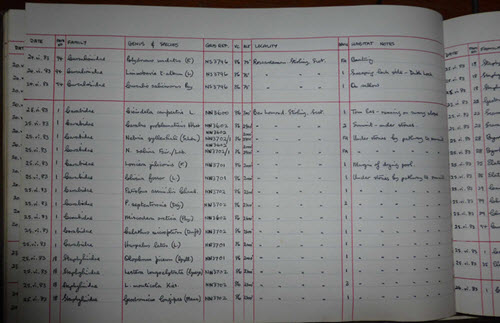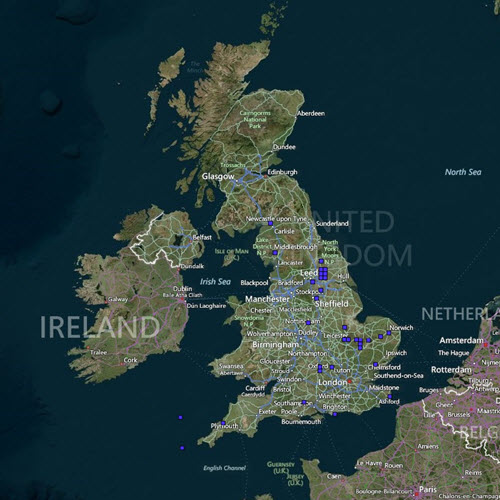Written by Steve Whitbread, Northamptonshire Biodiversity Records Centre
NBN’s first Data Capture Initiative yielded a wide variety of datasets, indicative of just how much historic data remains ‘in the wild’. Of the several sets tackled by Northamptonshire Biodiversity Records Centre, one offers an excellent example of where a keen recorder, starting out in the 1970s, and amassing numerous records in written form before progressing to computer storage, never found time to digitise their older data.
Tony Drane’s beetle records, commencing with a set of three carefully ruled ledgers, open with a record of Haliplus ruficollis (Degeer), a wide-spread water beetle now known as Haliplus (Haliplinus) ruficollis (De Geer, 1774). Whilst there is a wonderful abundance of beetle species, it seems that Coleopterists also have an inordinate fondness for names. The UK Species Inventory currently sports some 14,000 appellations for the assorted families, genera et al, including the 4,000 plus recognised species recorded from these islands, and that’s even without including the most recent checklist revisions.
Averaging more than a 1,000 records a year between 1977 and 1985, Tony quickly filled his brown log books. His ‘blue folder period’, between 1984 and 1991, saw him introduce a standard recording sheet, on which he noted the main habitat types found at each location, together with more detailed microhabitat and sampling data. Going through the records (digitised by Katie Jolly), and looking at the range of animal corpses, types of dung, and plant types the records provide rather more than just Who, What, Where and When. It’s also possible to track Tony’s growing experience and patterns of recording.
By 1991, Tony had amassed more than 12,000 records. More than a third of these came from his home county of Northamptonshire. Most of the rest were gathered in the East Midlands or East of England. He seems to have covered all possible habitats and microhabitats, recording in excess of 100 beetle species at 17 of the 400 plus locations he visited. Wicken Fen alone contributed 528 species, making up more than a tenth of the dataset and reflecting the considerable effort he expended here.

Beyond the descriptive statistics, it is what can be done with such records that is most likely to encourage others to ‘unleash their shoeboxes’. Knowledge of which species are of local/national conservation value, and of the assemblages and conditions indicated by their co-occurrence and relative abundance, can turn collections of historic records into snapshots of the past, enabling understanding of change over time and the targeting of future conservation effort. Natural England’s spreadsheet summaries of its reviews of rare and threatened beetles is a definite help here. Not all species groups are covered at present, but Tony’s leaf beetle records include six species considered to be vulnerable to extinction and six that are already endangered, under current IUCN redlist criteria. Others accorded RDB status in the original insect red data book (Shirt, 1987), reflects the increased knowledge we now have thanks to the work of the agencies, and to individual recorders in particular.
The aggregation of data via the NBN, gives added value, providing context to individual records or datasets. From Wicken Fen, Tony had records of Tansy Beetle Chrysolina graminis (Linnaeus, 1758) a BAP priority species, on several occasions during 1977-91, but none from repeat visits to similar sites including the National Trust’s Woodwalton Fen. This might be taken to suggest that 2014’s re-finding of this species at Woodwalton (by Peter Kirby), the first record since 1971, is indicative of a change in site conditions. Examination of the changes in broader species composition, as revealed by historical records – where available – enables such tentative suppositions to be evaluated.

Whilst it’s unlikely that a young Tony Drane gave it much thought when he encountered that first water beetle, four decades ago, like other recorders before and since he’s made a real contribution to our understanding nationally. He’s also provided a significant boost in relation to a group for which we have all too little information locally. Future beetle recorders will benefit from this growing and increasingly accessible and usable body of knowledge, as well as from resources such as the UK Coleoptera website.
As for what’s next, if the NBN Data Capture Initiative helps stimulate further historic data digitisation, we’ll very definitely be seeking to process Tony’s predecessors’ notebooks – as well as looking for quicker ways to manage historic data entry and to convert old names to new. Our very grateful thanks to Tony for sharing his records – and all his efforts in making them – and to the Secretariat of the NBN, UK Species Inventory, and Cabinet Office for their support.
If you would like to submit information on undigitised data please complete the NBN Inventory of Undigitised data form. You can find out more about this here.
